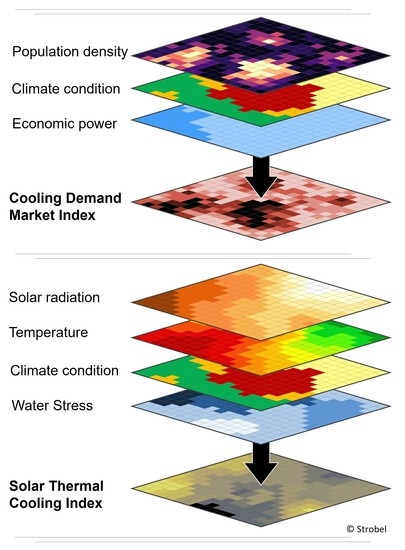Spatial Distribution of Future Demand for Space Cooling Applications and Potential of Solar Thermal Cooling Systems
Abstract
:1. Introduction
2. Materials and Methods
2.1. Factors Influencing Space Cooling Demand
2.1.1. Building Design and Structure Strategies
2.1.2. Low-Energy Cooling Strategies
2.1.3. Mitigation of Urban Heat Islands (UHI)
2.2. Solar Options to Answer the Cooling Demand
2.2.1. Solar Cooling Technologies
2.2.2. International Energy Agency (IEA) Solar Heating and Cooling (SHC) Task 65—Solar Cooling for the Sunbelt Regions
2.3. Future Scenarios Considered
- SSP1-2.6: This scenario considers the least global warming (RCP 2.6) of all scenarios assessed. The SSP1 scenario considers the lowest world population in 2050 compared to the other SSP scenarios because of investments into peoples’ education and health. This scenario represents the most environment-friendly way and dissipates from resource-intensive development [103].
- SSP2-4-5: This scenario considers global warming in the middle of the 21st century between 0.9 °C and 2.0 °C, relative to the reference period of 1986–2005 [101] (p. 90). The socioeconomic developments follow historical patterns, with a perfect globally connected market, uneven developments in economic growth and only slow progress in achieving sustainability goals [103].
- SSP4-6.0: This scenario considers global warming in the middle of the 21st century between 0.8 °C and 1.8 °C, relative to the reference period of 1986–2005 [101] (p. 90). The global warming in scenario RCP 6.0 is going to run predominantly during the second half of the 21st century. SSP4 represents an international as well as national inequality socioeconomic development. Economic growth is moderate. A great disparity between a well-educated and capital-intensive society and a low-income and labor-intensive one is growing worldwide [103].
- SSP5-8.5: This scenario considers a strong increase in CO2 emissions and an increase in global mean surface temperature between 1.4 °C and 2.6 °C, relative to the reference period of 1986–2005 by the middle of the 21st century [101] (p. 90). The socioeconomic developments are influenced by energy-intensive and fossil-fueled technologies. This leads to economic and capital growth in emerging economies, along with high investments in health, education, and institutions to enhance human and social capital [103].
2.4. Development of Methodologies
2.5. Cooling Demand Market Index
2.5.1. Previous Studies
2.5.2. Developed Methodology
2.5.3. Rating of Climate Zones
2.5.4. Rating of Population Density
2.5.5. Rating of Economic Power
2.5.6. Calculation of CDMI
2.6. Solar Thermal Cooling Index
2.6.1. Developed Methodology
2.6.2. Availability of Solar Radiation and Solar Thermal Collector Efficiency
2.6.3. Ambient Temperature
2.6.4. Water Stress (WS)
2.6.5. Climate Zone
2.6.6. Calculation of STCI
3. Results
3.1. Cooling Demand Market Index (CDMI)
3.2. Future Solar Thermal Cooling Index
3.3. Potential of Solar Thermal Cooling Based on Both Indeces
4. Discussion
4.1. Discussion on Results
4.2. Uncertainties in Methodologies
4.3. Comparison to Other Studies
5. Conclusions
- The growing population and especially the increasing economic power of developing countries are the main drivers of future demand for cooling appliances.
- In all four future scenarios analyzed, India, China, the United States, Indonesia, Nigeria, Pakistan, Brazil, Mexico and Egypt are the countries with the highest CDMI in 2050.
- The highest percentage increase in national CDMI is found in African countries.
- Cooling demand hot spots, which are characterized by high population density, hot climate and sufficient economic power to purchase cooling applications, are primarily located in Africa, south and southeast Asia and south America.
- The STCI indicates the highest potential of solar thermal cooling systems, especially in Africa and the United States.
- The application of wet coolers is restricted as arid air conditions and the availability of water are required. This hinders the application of chillers using LiBr, which require a lower cooling temperature than other chillers, in large areas of the world.
- Regarding sorption chiller systems, absorption chillers using ammonia and adsorption chillers using zeolite have the potential to address the highest CDMI.
Author Contributions
Funding
Institutional Review Board Statement
Informed Consent Statement
Data Availability Statement
Conflicts of Interest
Abbreviations and Symbol
| Abbreviation | Meaning |
| AbC | Absorption Chiller |
| AdC | Adsorption Chiller |
| ASEAN | Association of Southeast Asian Nations |
| BEEN | Building Energy Efficiency in Nepal (SWITCH-Asia project) |
| CDD | Cooling Degree Days |
| CDMI | Cooling Demand Market Index |
| COPth | Thermal Coefficient of Performance |
| ETC | Evacuated Tube Collector |
| GDP | Gross Domestic Product |
| GHG | Greenhouse Gases |
| GHI | Global Horizontal Irradiation |
| GIS | Geographical Information System |
| HDD | Heating Degree Days |
| IEA | International Energy Agency |
| IIASA | International Institute for Applied Systems Analysis |
| IPCC | Intergovernmental Panel on Climate Change |
| PCM | Phase Change Material |
| PVT | Photovoltaic Thermal (Collector) |
| SHC | Solar Heating and Cooling |
| SHGC | Solar Heat Gain Coefficient |
| STCI | Solar Thermal Cooling Index |
| UHI | Urban Heat Island |
| VCC | Vapor Compression Chiller |
| WS | Water Stress |
| Symbol | Meaning |
| XClimate | Rating of climate zone (following Köppen-Geiger climate classification) between 0 and 10. This dimensionless factor is based on an analysis of CDD. A high score corelates with a high number of CDD and represents a higher demand for cooling. |
| XPopulation | Rating of population density with values between 0 (no population) to 10 (population density of ≥10,000 persons/km²). |
| XEconomic Power | Rating of economic power per country or region with values between 0 and 10. It’s based on the national GDP per capita. The rating increases logarithmically from 0 (0 $/capita) to 10 (≥30,000 $/capita). |
| Tcool, dry | Inlet heat rejection temperature running into the chiller, exiting a dry cooler. This temperature is defined as 2 K above ambient dry bulb temperature. |
| Tcool, wet | Inlet heat rejection temperature running into the chiller, exiting a wet cooler. This temperature is defined as 3 K below ambient dry bulb temperature. |
| Tcool | Resulting inlet heat rejection temperature to consider in the STCI calculation. Based on climate condition, it’s either Tcool,dry or Tcool,wet. |
| YT,cool | Rating of Tcool, based on individual behavior of different chiller types between 0.5 and 1. |
| Solar yieldTm | This parameter indicates the solar thermal yield of an evacuated tube collector based on the average daily solar radiation per m². |
Appendix A
| Code | Description |
|---|---|
| Af | Tropical, rainforest |
| Am | Tropical, monsoon |
| Aw | Tropical, savannah |
| BWh | Arid, desert, hot |
| BWk | Arid, desert, cold |
| BSh | Arid, steppe, hot |
| BSk | Arid, steppe, cold |
| Csa | Temperate, dry summer, hot summer |
| Csb | Temperate, dry summer, warm summer |
| Csc | Temperate, dry summer, cold summer |
| Cwa | Temperate, dry winter, hot summer |
| Cwb | Temperate, dry winter, warm summer |
| Cwc | Temperate, dry winter, cold summer |
| Cfa | Temperate, no dry season, hot summer |
| Cfb | Temperate, no dry season, warm summer |
| Cfc | Temperate, no dry season, cold summer |
| Dsa | Cold, dry summer, hot summer |
| Dsb | Cold, dry summer, warm summer |
| Dsc | Cold, dry summer, cold summer |
| Dsd | Cold, dry summer, very cold winter summer |
| Dwa | Cold, dry winter, hot summer |
| Dwb | Cold, dry winter, warm summer |
| Dwc | Cold, dry winter, cold summer |
| Dwd | Cold, dry winter, very cold winter |
| Dfd | Cold, no dry season, hot summer |
| Dfb | Cold, no dry season, warm summer |
| Dfc | Cold, no dry season, cold summer |
| Dfd | Cold, no dry season, very cold winter |
| ET | Polar, tundra |
| EF | Polar, frost |
References
- World Metereological Organization. Past Eight Years Confirmed to Be the Eight Warmest on Record; Press Release Number: 12012023; WMO: Geneva, Switzerland, 2023. [Google Scholar]
- Masson-Delmotte, V.; Zhai, P.; Pirani, A.; Connors, C.P.; Péan, C.; Berger, S.; Caud, N.; Chen, Y.; Goldfarb, L.; Gomis, M.I. (Eds.) IPCC, 2021: Summary for Policymakers. In Climate Change 2021: The Physical Science Basis. Contribution of Working Group I to the Sixth Assessment Report of the Intergovernmental Panel on Climate Change; Cambridge University Press: Cambridge, UK; New York, NY, USA, 2021; pp. 3–32. [Google Scholar]
- Copernicus Climate Change Service. Global Climate Highlights: 2022 Saw Record Temperature in Europe and across the World. Available online: https://climate.copernicus.eu/2022-saw-record-temperatures-europe-and-across-world (accessed on 1 March 2023).
- Pörtner, H.-O.; Roberts, D.C.; Adams, H.; Adelekan, I.; Adler, C.; Adrian, R.; Aldunce, P.; Ali, E.; Ara Begum, R.; Bednar-Friedl, B.; et al. Climate Change 2022: Impacts, Adaptation and Vulnerability: Contribution of Working Group II to the Sixth Assessment Report of the Intergovernmental Panel on Climate Change; Cambridge University Press: Cambridge, UK; New York, NY, USA, 2022. [Google Scholar]
- Pavanello, F.; de Cian, E.; Davide, M.; Mistry, M.; Cruz, T.; Bezerra, P.; Jagu, D.; Renner, S.; Schaeffer, R.; Lucena, A.F.P. Air-conditioning and the adaptation cooling deficit in emerging economies. Nat. Commun. 2021, 12, 6460. [Google Scholar] [CrossRef]
- Dean, B.; Dulac, J.; Morgan, T.; Remme, U. The Future of Cooling: Opportunities for Energy-Efficient Air Conditioning. 2018. Available online: https://www.iea.org/reports/the-future-of-cooling (accessed on 8 June 2023).
- Zachariah, M.; Arulala, T.; Krishna, A.R.; Saeed, F.; Jha, R.; Dhasmana, M.K.; Mondal, A.; Bonnet, R.; Vautard, R.; Philip, S.; et al. Climate Change Made Devastating Early Heat in India and Pakistan 30 Times More Likely. 2022. Available online: https://www.worldweatherattribution.org/climate-change-made-devastating-early-heat-in-india-and-pakistan-30-times-more-likely/ (accessed on 13 January 2023).
- Rousi, E.; Kornhuber, K.; Beobide-Arsuaga, G.; Luo, F.; Coumou, D. Accelerated western European heatwave trends linked to more-persistent double jets over Eurasia. Nat. Commun. 2022, 13, 3851. [Google Scholar] [CrossRef]
- Amodeao, M.; Bauer, M.; Kyra, B.; Cawley, H.; Chadwick, S.; Eby, M.; Freeman, N.; Hoang, T.; Hsieh, H.; Kaminski, M.; et al. The 6th National Risk Assessment: Hazardous Heat; First Street Foundation: New York, NY, USA, 2022. [Google Scholar]
- Summary for Policymakers. In Global Warming of 1.5°C: An IPCC Special Report on the Impacts of Global Warming of 1.5°C above Pre-Industrial Levels and Related Global Greenhouse Gas Emission Pathways, in the Context of Strengthening the Global Response to the Threat of Climate Change, Sustainable Development, and Efforts to Eradicate Poverty; IPCC (Ed.) Cambridge University Press: Cambridge, UK; New York, NY, USA, 2022; pp. 3–24. ISBN 9781009157940. [Google Scholar]
- World Bank Group. World GDP 1960–2023. Available online: https://www.macrotrends.net/countries/WLD/world/gdp-gross-domestic-product (accessed on 1 March 2023).
- IEA. Key World Energy Statistics 2021: Final Consumption, World Total Final Consumption (TFC) by Source. Available online: https://www.iea.org/reports/key-world-energy-statistics-2020/final-consumption (accessed on 1 March 2023).
- IEA. Global Energy-Related CO2 Emissions, 1990–2020. Available online: https://www.iea.org/data-and-statistics/charts/global-energy-related-co2-emissions-1990-2020 (accessed on 1 March 2023).
- United Nations, Department of Economic and Social Affairs, Population Division. World Population Prospects: The 2022 Revision, Online Edition. Available online: https://population.un.org/dataportal/data/indicators/49/locations/900/start/1950/end/2100/line/linetimeplotsingle (accessed on 1 March 2023).
- IEA. Space Cooling. Available online: https://www.iea.org/reports/space-cooling (accessed on 1 March 2023).
- IEA. The Future of Cooling in Southeast Asia; International Energy Agency: Paris, France, 2019. [Google Scholar]
- Sherman, P.; Lin, H.; McElroy, M. Projected global demand for air conditioning associated with extreme heat and implications for electricity grids in poorer countries. Energy Build. 2022, 268, 112198. [Google Scholar] [CrossRef]
- Li, D.H.; Yang, L.; Lam, J.C. Impact of climate change on energy use in the built environment in different climate zones—A review. Energy 2012, 42, 103–112. [Google Scholar] [CrossRef]
- Cui, D.; Liang, S.; Wang, D. Observed and projected changes in global climate zones based on Köppen climate classification. WIREs Clim. Chang. 2021, 12, e701. [Google Scholar] [CrossRef]
- Sachar, S.; Campbell, I.; Kalanki, A. Solving the Clobal Cooling Challenge: How to Encounter the Climate Threat from Room Air Conditoners. 2018. Available online: https://rmi.org/wp-content/uploads/2018/11/Global_Cooling_Challenge_Report_2018.pdf (accessed on 1 August 2022).
- SWITCH-Asia Programme; European Commission. Buliding Energy Efficiency in Nepal (BEEN): Promoting Climate-Responsive Building Design and Retrofitting. Available online: https://www.switch-asia.eu/project/building-energy-efficiency-in-nepal-been/ (accessed on 19 March 2023).
- United Nations, Department of Economic and Social Affairs, Population Division. World Urbanization Prospects: The 2018 Revision. 2018. Available online: https://population.un.org/wup/Download/ (accessed on 7 March 2023).
- Crespo Cuaresma, J. Income projections for climate change research: A framework based on human capital dynamics. Glob. Environ. Chang. 2017, 42, 226–236. [Google Scholar] [CrossRef] [Green Version]
- Wagner, A. Exploring Occupant Behavior in Buildings: Methods and Challenges; Springer: Cham, Switzerland, 2018; ISBN 978-3-319-61464-9. [Google Scholar]
- Díaz, J.A.; Jiménez, M.J. Experimental assessment of room occupancy patterns in an office building. Comparison of different approaches based on CO2 concentrations and computer power consumption. Appl. Energy 2017, 199, 121–141. [Google Scholar] [CrossRef]
- Pacheco, R.; Ordóñez, J.; Martínez, G. Energy efficient design of building: A review. Renew. Sustain. Energy Rev. 2012, 16, 3559–3573. [Google Scholar] [CrossRef]
- Gupta, N.; Tiwari, G.N. Review of passive heating/cooling systems of buildings. Energy Sci. Eng. 2016, 4, 305–333. [Google Scholar] [CrossRef] [Green Version]
- Al Dakheel, J.; Tabet Aoul, K. Building Applications, Opportunities and Challenges of Active Shading Systems: A State-of-the-Art Review. Energies 2017, 10, 1672. [Google Scholar] [CrossRef] [Green Version]
- Schnieders, J.; Feist, W.; Schulz, T.; Benjamin, K.; Rongen, L.; Wirtz, R. Passivhäuser für Verschiedene Klimazonen: Abschlussbericht; gefördert unter dem Az: 26577 von der Deutschen Bundesstiftung Umwelt; Wolfgang Feist: Darmstadt, Germany, 2011. [Google Scholar]
- Friedrichsen, S. Nachhaltiges Planen, Bauen und Wohnen; Springer: Berlin/Heidelberg, Germany, 2018; ISBN 978-3-662-56552-0. [Google Scholar]
- Shree, V.; Goyal, N.; Saxena, A.; Bhattacharyya, S.; Dwivedi, A.; Goel, V. Assessment of thermal loading in energy-efficient buildings: Parametric review on the window design aspects. J. Therm. Anal. Calorim. 2023, 148, 2703–2718. [Google Scholar] [CrossRef]
- Elaouzy, Y.; El Fadar, A. Energy, economic and environmental benefits of integrating passive design strategies into buildings: A review. Renew. Sustain. Energy Rev. 2022, 167, 112828. [Google Scholar] [CrossRef]
- Jomehzadeh, F.; Nejat, P.; Calautit, J.K.; Yusof, M.B.M.; Zaki, S.A.; Hughes, B.R.; Yazid, M.N.A.W.M. A review on windcatcher for passive cooling and natural ventilation in buildings, Part 1: Indoor air quality and thermal comfort assessment. Renew. Sustain. Energy Rev. 2017, 70, 736–756. [Google Scholar] [CrossRef]
- Kolokotsa, D.-D.; Giannariakis, G.; Gobakis, K.; Giannarakis, G.; Synnefa, A.; Santamouris, M. Cool roofs and cool pavements application in Acharnes, Greece. Sustain. Cities Soc. 2018, 37, 466–474. [Google Scholar] [CrossRef]
- Yuan, J.; Emura, K.; Sakai, H. Evaluation of the solar reflectance of highly reflective roofing sheets installed on building roofs. J. Build. Phys. 2013, 37, 170–184. [Google Scholar] [CrossRef]
- D’Orazio, M.; Di Perna, C.; Di Giuseppe, E. Green roof yearly performance: A case study in a highly insulated building under temperate climate. Energy Build. 2012, 55, 439–451. [Google Scholar] [CrossRef]
- Jaffal, I.; Ouldboukhitine, S.-E.; Belarbi, R. A comprehensive study of the impact of green roofs on building energy performance. Renew. Energy 2012, 43, 157–164. [Google Scholar] [CrossRef]
- Gholamibozanjani, G.; Farid, M. A Critical Review on the Control Strategies Applied to PCM-Enhanced Buildings. Energies 2021, 14, 1929. [Google Scholar] [CrossRef]
- Zeinelabdein, R.; Omer, S.; Gan, G. Critical review of latent heat storage systems for free cooling in buildings. Renew. Sustain. Energy Rev. 2018, 82, 2843–2868. [Google Scholar] [CrossRef]
- Souayfane, F.; Fardoun, F.; Biwole, P.-H. Phase change materials (PCM) for cooling applications in buildings: A review. Energy Build. 2016, 129, 396–431. [Google Scholar] [CrossRef]
- Uehara, Y.; Uno, T. Evaluation of Energy-Saving and Improvement of the Thermal Environment of the House with High Thermal Insulation, Heat Storage Performance, and Fitting Adjustment. Energies 2022, 15, 6728. [Google Scholar] [CrossRef]
- Andric, I.; Kamal, A.; Al-Ghamdi, S.G. Efficiency of green roofs and green walls as climate change mitigation measures in extremely hot and dry climate: Case study of Qatar. Energy Rep. 2020, 6, 2476–2489. [Google Scholar] [CrossRef]
- Irshad, A.S.; Noori, A.G. Evaluating the effects of passive cooling and heating techniques on building energy consumption in Kandahar using CLTD method. Mater. Today: Proc. 2022, 57, 595–602. [Google Scholar] [CrossRef]
- Ávila-Hernández, A.; Simá, E.; Ché-Pan, M. Research and development of green roofs and green walls in Mexico: A review. Sci. Total Environ. 2022, 856, 158978. [Google Scholar] [CrossRef] [PubMed]
- Wijesuriya, S.; Kishore, R.A.; Bianchi, M.V.; Booten, C. Potential energy savings benefits and limitations of radiative cooling coatings for U.S. residential buildings. J. Clean. Prod. 2022, 379, 134763. [Google Scholar] [CrossRef]
- Garshasbi, S.; Feng, J.; Paolini, R.; Jonathan Duverge, J.; Bartesaghi-Koc, C.; Arasteh, S.; Khan, A.; Santamouris, M. On the energy impact of cool roofs in Australia. Energy Build. 2023, 278, 112577. [Google Scholar] [CrossRef]
- Clarivate. Web of Science—Search. Available online: https://www.webofscience.com/wos/woscc/basic-search (accessed on 19 March 2023).
- Duan, Z.; Zhan, C.; Zhang, X.; Mustafa, M.; Zhao, X.; Alimohammadisagvand, B.; Hasan, A. Indirect evaporative cooling: Past, present and future potentials. Renew. Sustain. Energy Rev. 2012, 16, 6823–6850. [Google Scholar] [CrossRef]
- Yang, Y.; Cui, G.; Lan, C.Q. Developments in evaporative cooling and enhanced evaporative cooling—A review. Renew. Sustain. Energy Rev. 2019, 113, 109230. [Google Scholar] [CrossRef]
- Ito, S.; Miura, N. Studies of Radiative Cooling Systems for Storing Thermal Energy. J. Sol. Energy Eng. 1989, 111, 251–256. [Google Scholar] [CrossRef]
- Ezekwe, C.I. Performance of a heat pipe assisted night sky radiative cooler. Energy Convers. Manag. 1990, 30, 403–408. [Google Scholar] [CrossRef]
- Vall, S.; Castell, A. Radiative cooling as low-grade energy source: A literature review. Renew. Sustain. Energy Rev. 2017, 77, 803–820. [Google Scholar] [CrossRef] [Green Version]
- Eicker, U.; Dalibard, A. Photovoltaic–thermal collectors for night radiative cooling of buildings. Sol. Energy 2011, 85, 1322–1335. [Google Scholar] [CrossRef]
- Wang, W.; Fernandez, N.; Katipamula, S.; Alvine, K. Performance assessment of a photonic radiative cooling system for office buildings. Renew. Energy 2018, 118, 265–277. [Google Scholar] [CrossRef]
- Su, M.A.; Ngarambe, J.; Santamouris, M.; Yun, G.Y. Empirical evidence on the impact of urban overheating on building cooling and heating energy consumption. iScience 2021, 24, 102495. [Google Scholar] [CrossRef]
- Mentaschi, L.; Duveiller, G.; Zulian, G.; Corbane, C.; Pesaresi, M.; Maes, J.; Stocchino, A.; Feyen, L. Global long-term mapping of surface temperature shows intensified intra-city urban heat island extremes. Glob. Environ. Chang. 2022, 72, 102441. [Google Scholar] [CrossRef]
- Moustris, K.P.; Zacharia, P.; Larissi, I.K.; Nastos, P.T.; Paliatsos, A.G. Cooling and Heating Degree-Days Calculation for representative Locations within the Greater Athens Area, Greece. Rhodes, Greece. Available online: https://www.researchgate.net/publication/233776116 (accessed on 18 August 2022).
- Boudali Errebai, F.; Strebel, D.; Carmeliet, J.; Derome, D. Impact of urban heat island on cooling energy demand for residential building in Montreal using meteorological simulations and weather station observations. Energy Build. 2022, 273, 112410. [Google Scholar] [CrossRef]
- Li, X.; Zhou, Y.; Yu, S.; Jia, G.; Li, H.; Li, W. Urban heat island impacts on building energy consumption: A review of approaches and findings. Energy 2019, 174, 407–419. [Google Scholar] [CrossRef]
- Mihalakakou, G.; Flocas, H.A.; Santamouris, M.; Helmis, C.G. Application of Neural Networks to the Simulation of the Heat Island over Athens, Greece, Using Synoptic Types as a Predictor. J. Appl. Meteorol. 2002, 41, 519–527. [Google Scholar] [CrossRef]
- Roy, S.; Akther, M.; Sumi, F.; Hoque, M.; Dutta, S. Factors Influencing Urban Heat Island Formation and its Effects on Public Health in Bangladesh. IOSR J. Environ. Sci. Toxicol. Food Technol. 2019, 13, 77–87. [Google Scholar]
- Dixon, P.G.; Mote, T.L. Patterns and Causes of Atlanta’s Urban Heat Island–Initiated Precipitation. J. Appl. Meteor. 2003, 42, 1273–1284. [Google Scholar] [CrossRef]
- Wardeh, Y.; Kinab, E.; Escadeillas, G.; Rahme, P.; Ginestet, S. Review of the optimization techniques for cool pavements solutions to mitigate Urban Heat Islands. Build. Environ. 2022, 223, 109482. [Google Scholar] [CrossRef]
- Wang, C.; Ren, Z.; Dong, Y.; Zhang, P.; Guo, Y.; Wang, W.; Bao, G. Efficient cooling of cities at global scale using urban green space to mitigate urban heat island effects in different climatic regions. Urban For. Urban Green. 2022, 74, 127635. [Google Scholar] [CrossRef]
- Algretawee, H.; Rayburg, S.; Neave, M. Estimating the effect of park proximity to the central of Melbourne city on Urban Heat Island (UHI) relative to Land Surface Temperature (LST). Ecol. Eng. 2019, 138, 374–390. [Google Scholar] [CrossRef]
- Semenzato, P.; Bortolini, L. Urban Heat Island Mitigation and Urban Green Spaces: Testing a Model in the City of Padova (Italy). Land 2023, 12, 476. [Google Scholar] [CrossRef]
- Lemoine-Rodríguez, R.; Inostroza, L.; Falfán, I.; MacGregor-Fors, I. Too hot to handle? On the cooling capacity of urban green spaces in a Neotropical Mexican city. Urban For. Urban Green. 2022, 74, 127633. [Google Scholar] [CrossRef]
- Alavipanah, S.; Wegmann, M.; Qureshi, S.; Weng, Q.; Koellner, T. The Role of Vegetation in Mitigating Urban Land Surface Temperatures: A Case Study of Munich, Germany during the Warm Season. Sustainability 2015, 7, 4689–4706. [Google Scholar] [CrossRef] [Green Version]
- Yu, Z.; Xu, S.; Zhang, Y.; Jørgensen, G.; Vejre, H. Strong contributions of local background climate to the cooling effect of urban green vegetation. Sci. Rep. 2018, 8, 6798. [Google Scholar] [CrossRef] [Green Version]
- Iaria, J.; Susca, T. Analytic Hierarchy Processes (AHP) evaluation of green roof- and green wall- based UHI mitigation strategies via ENVI-met simulations. Urban Clim. 2022, 46, 101293. [Google Scholar] [CrossRef]
- Cuce, E. Thermal regulation impact of green walls: An experimental and numerical investigation. Appl. Energy 2017, 194, 247–254. [Google Scholar] [CrossRef]
- Governatori, M.; Cedillo-González, E.I.; Manfredini, T.; Siligardi, C. Solar reflective properties of porcelain tiles for UHI mitigation: Effect of highly reflective frits in the engobe’s formulation. Mater. Today Sustain. 2022, 20, 100255. [Google Scholar] [CrossRef]
- Wu, Z.; Zhang, Y. Water Bodies’ Cooling Effects on Urban Land Daytime Surface Temperature: Ecosystem Service Reducing Heat Island Effect. Sustainability 2019, 11, 787. [Google Scholar] [CrossRef] [Green Version]
- He, B.-J. Towards the next generation of green building for urban heat island mitigation: Zero UHI impact building. Sustain. Cities Soc. 2019, 50, 101647. [Google Scholar] [CrossRef]
- Garshasbi, S.; Haddad, S.; Paolini, R.; Santamouris, M.; Papangelis, G.; Dandou, A.; Methymaki, G.; Portalakis, P.; Tombrou, M. Urban mitigation and building adaptation to minimize the future cooling energy needs. Sol. Energy 2020, 204, 708–719. [Google Scholar] [CrossRef]
- Wang, C.; Wang, Z.-H.; Kaloush, K.E.; Shacat, J. Perceptions of urban heat island mitigation and implementation strategies: Survey and gap analysis. Sustain. Cities Soc. 2021, 66, 102687. [Google Scholar] [CrossRef]
- Campbell, I.; Sachar, S.; Meisel, J.; Nanavatty, R. Beating the Heat: A Sustainable Cooling Handbook for Cities; United Nations Environment Programme: Nairobi, Kenya, 2021; ISBN 978-92-807-3894-0. [Google Scholar]
- IEA SHC TCP Executive Committee. IEA SHC TCP Strategic Work Plan 2019–2024. 2018. Available online: https://www.iea-shc.org/Data/Sites/1/media/documents/members-area/shc_tcp-strategic_plan_2019-2024-final-aug_2018.pdf (accessed on 4 March 2023).
- Jakob, U. Solar cooling technologies. In Renewable Heating and Cooling; Elsevier: Amsterdam, The Netherlands, 2016; pp. 119–136. ISBN 9781782422136. [Google Scholar]
- Henning, H.-M. Solar Cooling Position Paper: IEA SHC Task 38 Solar Air-Conditioning and Refrigeration. 2011. Available online: http://www.iea-shc.org/data/sites/1/publications/IEA-SHC-Solar-Cooling-Position-Paper.pdf (accessed on 28 March 2023).
- Mugnier, D.; Jakob, U. Status of solar cooling in the World: Markets and available products. WIREs Energy Environ. 2015, 4, 229–234. [Google Scholar] [CrossRef]
- Jakob, U.; Neyer, D. Chapter 4.5: Solar Air Conditioning and Cooling. In Solar Heat Worldwide: Global Market Development and Trends 2021. Detailed Market Figures 2020; Edition 2022; Weiss, W., Spörk-Dür, M., Eds.; International Energy Agency: Paris, France, 2022; pp. 30–33. [Google Scholar]
- Jakob, U.; Neyer, D. Chapter 4.6: Solar Air Conditioning and Cooling. In Solar Heat Worldwide: Global Market Development and Trends in 2020. Detailed Market Figures 2019; Edition 2021; Weiss, W., Spörk-Dür, M., Eds.; International Energy Agency: Paris, France, 2021; pp. 28–31. [Google Scholar]
- Kohlenbach, P.; Jakob, U. Solar Cooling: The Earthscan Expert Guide to Solar Cooling Systems; Routledge: London, UK, 2013; ISBN 978-0-415-63975-0. [Google Scholar]
- Al-Yasiri, Q.; Szabó, M.; Arıcı, M. A review on solar-powered cooling and air-conditioning systems for building applications. Energy Rep. 2022, 8, 2888–2907. [Google Scholar] [CrossRef]
- Ghafoor, A.; Munir, A. Worldwide overview of solar thermal cooling technologies. Renew. Sustain. Energy Rev. 2015, 43, 763–774. [Google Scholar] [CrossRef]
- Neyer, D.; Jakob, U. Solar Cooling for the Sunbelt Regions—A new IEA SHC Task. In Proceedings of the ISES EuroSun 2020 Conference—13th International Conference on Solar Energy for Buildings and Industry, EuroSun 2020, Online, 1–3 September 2020; Charalambides, A., Streicher, W., Mugnier, D., Eds.; International Solar Energy Society: Freiburg, Germany, 2020; pp. 1–8. ISBN 978-3-9820408-2-0. [Google Scholar]
- IEA SHC. IEA-SHC Task65—About. Available online: https://task65.iea-shc.org/about (accessed on 13 February 2023).
- Jakob, U.; Vasta, S.; Weiss, W.; Neyer, D.; Kohlenbach, P. Solar Cooling for the Sunbelt Regions. In Proceedings of the ISES Solar World Congress 2021, Virtual, 25–29 October 2021; Renné, D., Weber, E., Hachem-Vermette, C., Frank, E., Eds.; International Solar Energy Society: Freiburg, Germany, 2021; pp. 1–8, ISBN 978-3-9820408-7-5. [Google Scholar]
- IEA SHC TCP Executive Committee. IEA SHC TCP Strategic Work Plan 2024–2029. 2023. Available online: https://www.iea-shc.org/Data/Sites/1/media/iea-shc-strategic-plan-2024-2029-final.pdf (accessed on 28 March 2023).
- Wang, X.; Meng, X.; Long, Y. Projecting 1 km-grid population distributions from 2020 to 2100 globally under shared socioeconomic pathways. Sci. Data 2022, 9, 563. [Google Scholar] [CrossRef]
- United Nations Development Programme. Table 2. Human Development Index trends, 1990–2021. Available online: https://hdr.undp.org/data-center/documentation-and-downloads (accessed on 13 March 2023).
- World Bank Group. World Bank Analytical Classifications: Historical Classification by Income. 2022. Available online: https://datahelpdesk.worldbank.org/knowledgebase/articles/906519-world-bank-country-and-lending-groups (accessed on 13 March 2023).
- The World Bank. GDP per Capita (Constant 2015 US$). Available online: https://data.worldbank.org/indicator/NY.GDP.PCAP.KD (accessed on 7 March 2023).
- Salata, F.; Falasca, S.; Ciancio, V.; Curci, G.; Grignaffini, S.; de Wilde, P. Estimating building cooling energy demand through the Cooling Degree Hours in a changing climate: A modeling study. Sustain. Cities Soc. 2022, 76, 103518. [Google Scholar] [CrossRef]
- Yaduvanshi, A.; Singh, R.; Kumar, R. Population changes and sustainability of energy drive cooling demand related risks in urbanized India. Energy Build. 2022, 260, 111891–111901. [Google Scholar] [CrossRef]
- Díaz-López, C.; Jódar, J.; Verichev, K.; Rodríguez, M.L.; Carpio, M.; Zamorano, M. Dynamics of Changes in Climate Zones and Building Energy Demand. A Case Study in Spain. Appl. Sci. 2021, 11, 4261. [Google Scholar] [CrossRef]
- Kirtman, B.; Power, S.B.; Adedoyin, J.A.; Boer, G.J.; Bojario, R.; Camilloni, I.; Doblas-Reyes, F.J.; Fiore, A.M.; Kimoto, M.; Meehl, G.A.; et al. Near-term Climate Change: Projections and Predictability. In Climate Change 2013: The Physical Science Basis. Contribution of Working Group I to the Fifth Assessment Report of the Intergovernmental Panel on Climate Change; Stocker, T.F., Qin, D., Plattner, G.K., Tignor, M., Allen, S.K., Boschung, J., Nauels, A., Xia, Y., Bex, V., Midgley, P.M., Eds.; Cambridge University Press: Cambridge, UK; New York, NY, USA, 2013; pp. 953–1028. [Google Scholar]
- Lee, J.-Y.; Marotzke, J.; Bala, G.; Cao, L.; Corti, S.; Dunne, J.P.; Engelbrecht, F.; Fischer, E.; Fyfe, J.C.; Jones, D.; et al. Future Global Climate: Scenario-Based Projections and Near-Term Information. In Climate Change 2021: The Physical Science Basis. Contribution of Working Group I to the Sixth Assessment Report of the Intergovernmental Panel on Climate Change; Masson-Delmotte, V., Zhai, P., Pirani, A., Connors, C.P., Péan, C., Berger, S., Caud, N., Chen, Y., Goldfarb, L., Gomis, M.I., et al., Eds.; Cambridge University Press: Cambridge, UK; New York, NY, USA, 2021; pp. 553–672. [Google Scholar]
- Van Vuuren, D.P.; Edmonds, J.; Kainuma, M.; Riahi, K.; Thomson, A.; Hibbard, K.; Hurtt, G.C.; Kram, T.; Krey, V.; Lamarque, J.-F.; et al. The representative concentration pathways: An overview. Clim. Chang. 2011, 109, 5–31. [Google Scholar] [CrossRef]
- IPCC. Scenario Process for AR5: Representative Concentration Pathways (RCPs). Available online: https://sedac.ciesin.columbia.edu/ddc/ar5_scenario_process/RCPs.html (accessed on 5 March 2023).
- O’Neill, B.C.; Kriegler, E.; Riahi, K.; Ebi, K.L.; Hallegatte, S.; Carter, T.R.; Mathur, R.; van Vuuren, D.P. A new scenario framework for climate change research: The concept of shared socioeconomic pathways. Clim. Chang. 2014, 122, 387–400. [Google Scholar] [CrossRef] [Green Version]
- O’Neill, B.C.; Kriegler, E.; Ebi, K.L.; Kemp-Benedict, E.; Riahi, K.; Rothman, D.S.; van Ruijven, B.J.; van Vuuren, D.P.; Birkmann, J.; Kok, K.; et al. The roads ahead: Narratives for shared socioeconomic pathways describing world futures in the 21st century. Glob. Environ. Chang. 2017, 42, 169–180. [Google Scholar] [CrossRef] [Green Version]
- Fuglestvedt, J.; Guivarch, C.; Jones, C.; Meinshausen, M.; Micholls, Z.R.; Platter, G.-K.; Riahi, K.; Rogelj, J.; Szopa, S.; Tebaldi, C.; et al. Cross-Chapter Box 1.4: The SSP Scenarios as Used in Working Group I (WGI). In Climate Change 2021: The Physical Science Basis. Contribution of Working Group I to the Sixth Assessment Report of the Intergovernmental Panel on Climate Change; Masson-Delmotte, V., Zhai, P., Pirani, A., Connors, C.P., Péan, C., Berger, S., Caud, N., Chen, Y., Goldfarb, L., Gomis, M.I., et al., Eds.; Cambridge University Press: Cambridge, UK; New York, NY, USA, 2021; pp. 232–236. [Google Scholar]
- Sachs, J.; Moya, D.; Giarola, S.; Hawkes, A. Clustered spatially and temporally resolved global heat and cooling energy demand in the residential sector. Appl. Energy 2019, 250, 48–62. [Google Scholar] [CrossRef]
- Mutschler, R.; Rüdisüli, M.; Heer, P.; Eggimann, S. Benchmarking cooling and heating energy demands considering climate change, population growth and cooling device uptake. Appl. Energy 2021, 288, 116636. [Google Scholar] [CrossRef]
- Enerdata. Future of Air-Conditioning: Executive Brief—September 2019. 2019. Available online: https://www.enerdata.net/publications/executive-briefing/future-air-conditioning.pdf (accessed on 11 May 2023).
- Isaac, M.; van Vuuren, D.P. Modeling global residential sector energy demand for heating and air conditioning in the context of climate change. Energy Policy 2009, 37, 507–521. [Google Scholar] [CrossRef]
- Andrijevic, M.; Byers, E.; Mastrucci, A.; Smits, J.; Fuss, S. Future cooling gap in shared socioeconomic pathways. Environ. Res. Lett. 2021, 16, 94053. [Google Scholar] [CrossRef]
- Mistry, M.N. A high-Resolution (0.25 Degree) Historical Global Gridded Dataset of Monthly and Annual Cooling and Heating Degree-Days (1970–2018) Based on GLDAS Data. 2019. Available online: https://doi.pangaea.de/10.1594/PANGAEA.903123 (accessed on 13 January 2023).
- Beck, H.E.; Zimmermann, N.E.; McVicar, T.R.; Vergopolan, N.; Berg, A.; Wood, E.F. Present and future Köppen-Geiger climate classification maps at 1-km resolution. Sci. Data 2018, 5, 180214. [Google Scholar] [CrossRef] [Green Version]
- Riahi, K.; Krey, V. Shared Socioeconomic Pathways Scenario Database (SSP): How it Works. Available online: https://iiasa.ac.at/models-tools-data/ssp (accessed on 3 March 2023).
- Organisation for Economic Co-operation and Development. Available online: https://www.oecd.org/sdd/na/statistical-insights-what-does-gdp-per-capita-tell-us-about-households-material-well-being.htm (accessed on 3 March 2023).
- Diacon, P.-E.; Maha, L.-G. The Relationship between Income, Consumption and GDP: A Time Series, Cross-Country Analysis. Procedia Econ. Financ. 2015, 23, 1535–1543. [Google Scholar] [CrossRef] [Green Version]
- Kc, S.; Lutz, W. The human core of the shared socioeconomic pathways: Population scenarios by age, sex and level of education for all countries to 2100. Glob. Environ. Chang. 2017, 42, 181–192. [Google Scholar] [CrossRef] [PubMed] [Green Version]
- Natural Earth. de Facto Country Boundaries. Available online: https://www.naturalearthdata.com/downloads/50m-cultural-vectors/50m-admin-0-countries-2/ (accessed on 6 March 2023).
- International Monetary Fund. GDP per Capita, Current Prices: U.S. Dollars per Capita. Available online: https://www.imf.org/external/datamapper/NGDPDPC@WEO/TWN?zoom=TWN&highlight=TWN (accessed on 6 March 2023).
- Kohlenbach, P.; Besana, F.; Jakob, U.; de Luca, M.; Moser, H.; Podesser, E.; Reinholdt, L.; Henning, H.-M.; Koller, T. Heat driven cooling technologies: Closed cycles. In Solar Cooling Handbook: A Guide to Solar Assisted Cooling and Dehumidification Processes; Ambra V: Wien, Austria, 2013; pp. 87–116. ISBN 978-3-99043-438-3. [Google Scholar]
- Luck, M.; Landis, M.; Gassert, F. Aqueduct Water Stress Projections: Decadal Projections of Water Supply and Demand Using CMIP5 GCMs; Technical Note; World Resources Institute: Washington, DC, USA, 2015. [Google Scholar]
- Global Solar Atlas. Longterm Average of Gloval Horizontal Irradiation—Global Solar Atlas. 2022. Available online: https://globalsolaratlas.info/download/world (accessed on 18 March 2023).
- Asian Development Bank. Aisa 2050: Realizing the Asian Century, Singapore. 2011. Available online: https://www.iopsweb.org/resources/48263622.pdf (accessed on 11 May 2023).
- African Development Bank. Africa in 50 Years’ Time: The Road Towards Inclusive Growth, Tunis, Tunisia. 2011. Available online: https://www.afdb.org/fileadmin/uploads/afdb/Documents/Publications/Africa%20in%2050%20Years%20Time.pdf (accessed on 11 May 2023).
- Searchinger, T.; Brown, M.; Campbell, B.; Carter, R.; Dickson, B. Chapter 2: Food Security and Livelihoods of Small-Scale Producers. In Adapt Now: A Global Call for Leadership on Climate Resilience; The Global Commission on Adaption: Rotterdam, Netherlands, 2019; pp. 23–29. [Google Scholar]
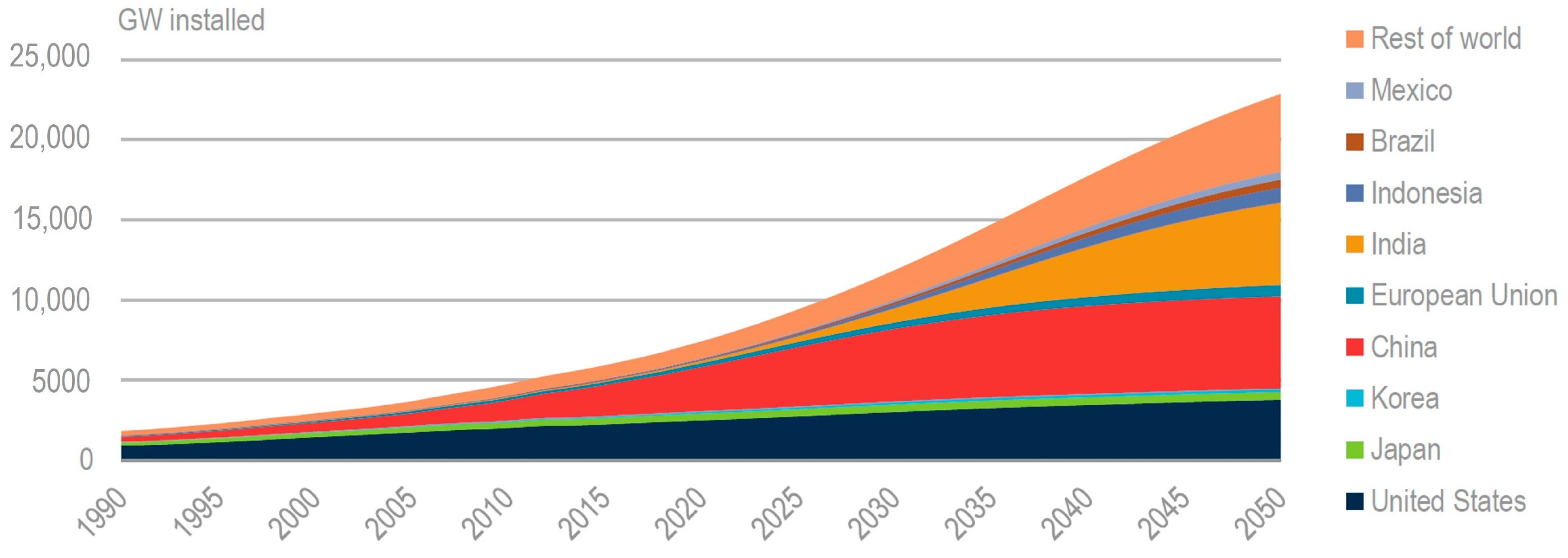
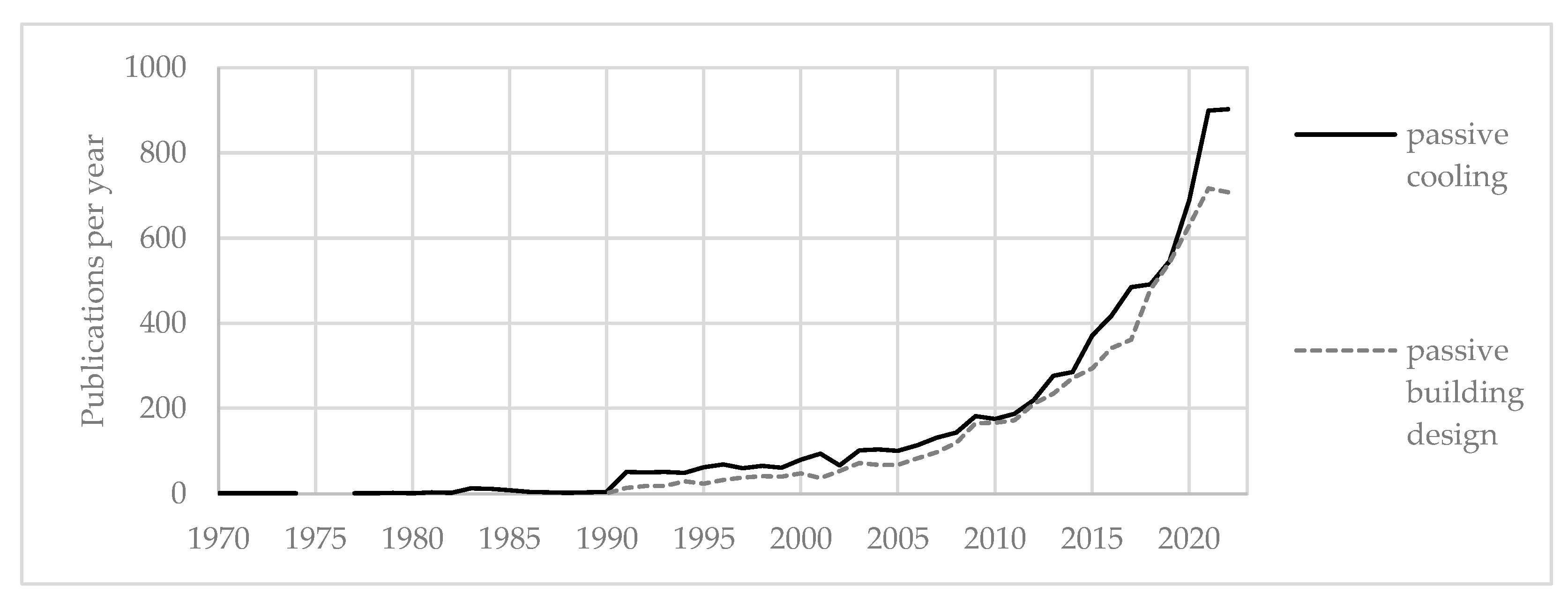
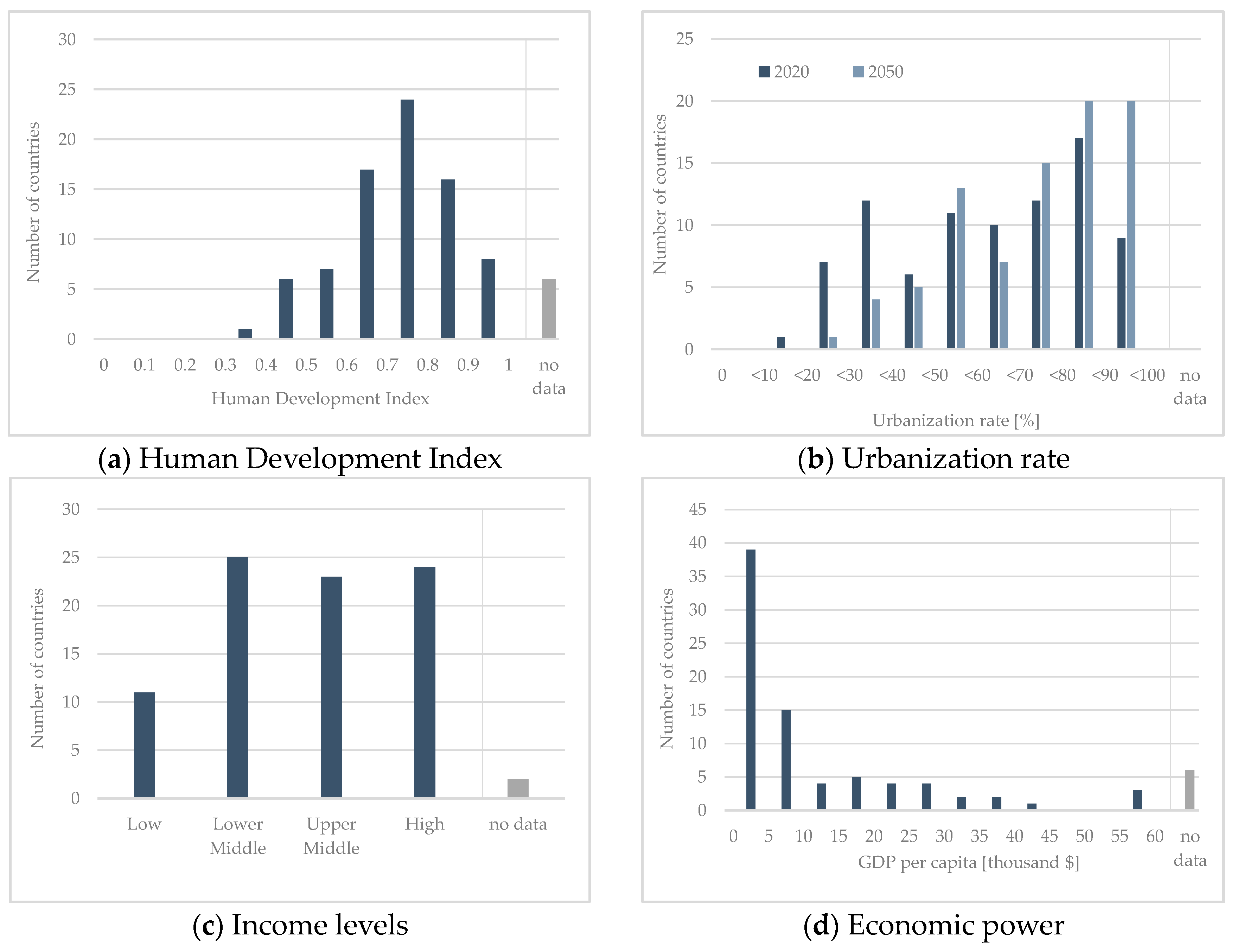
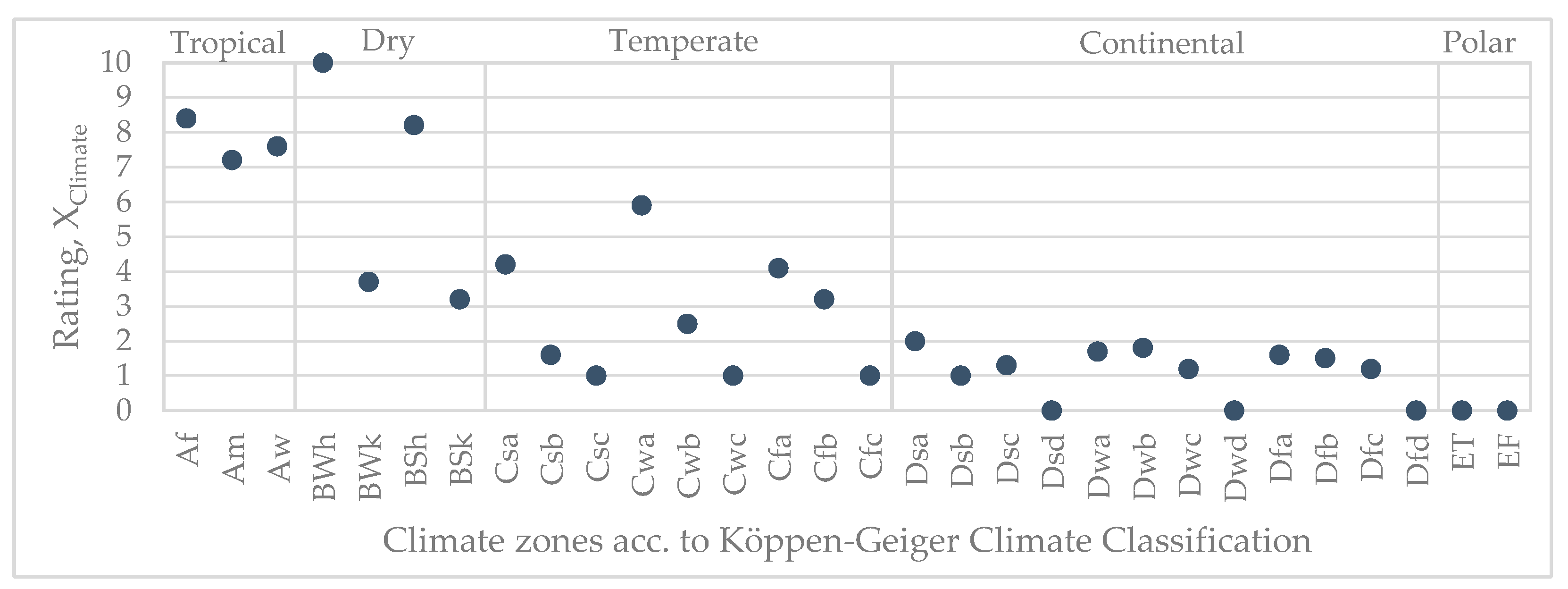
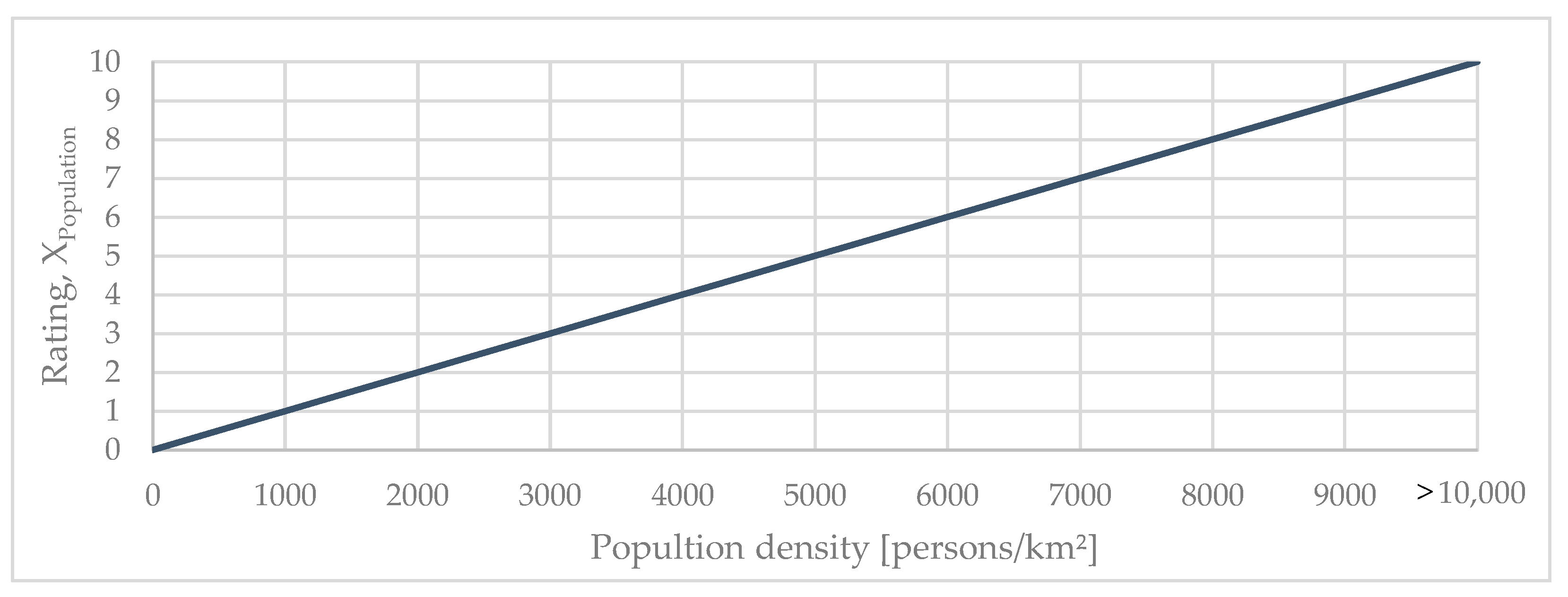
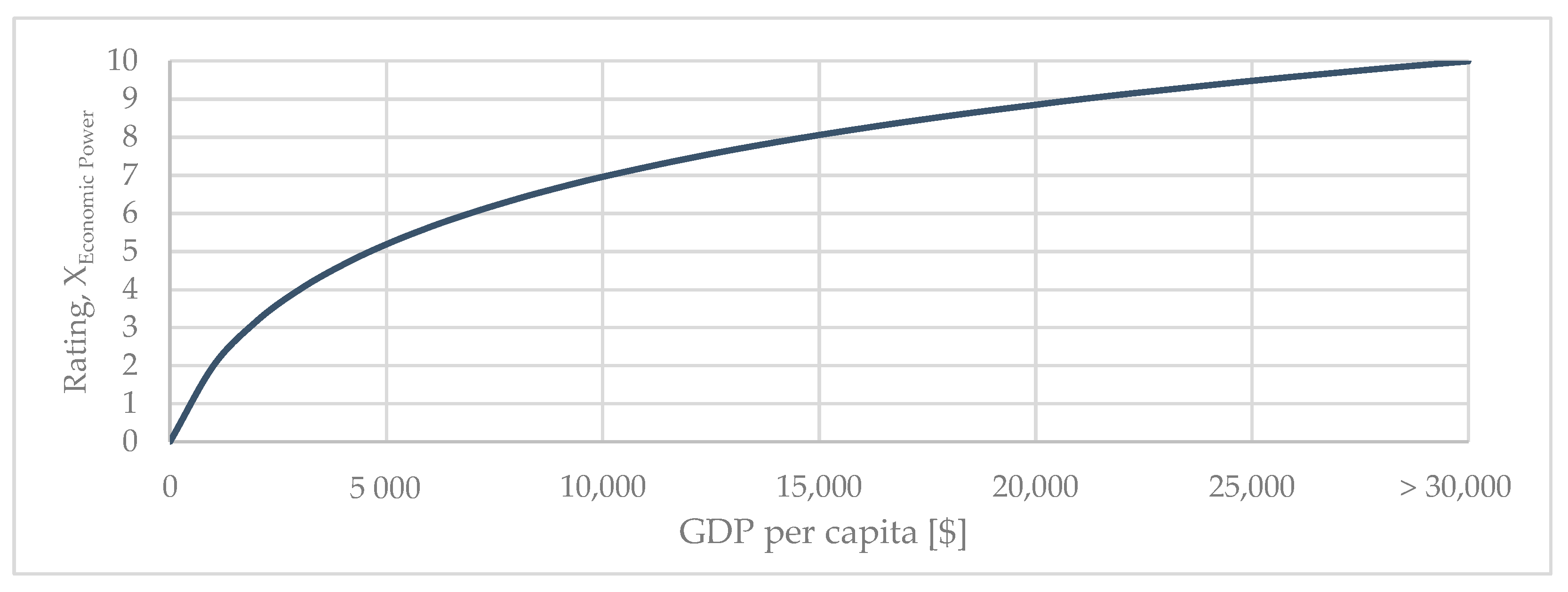

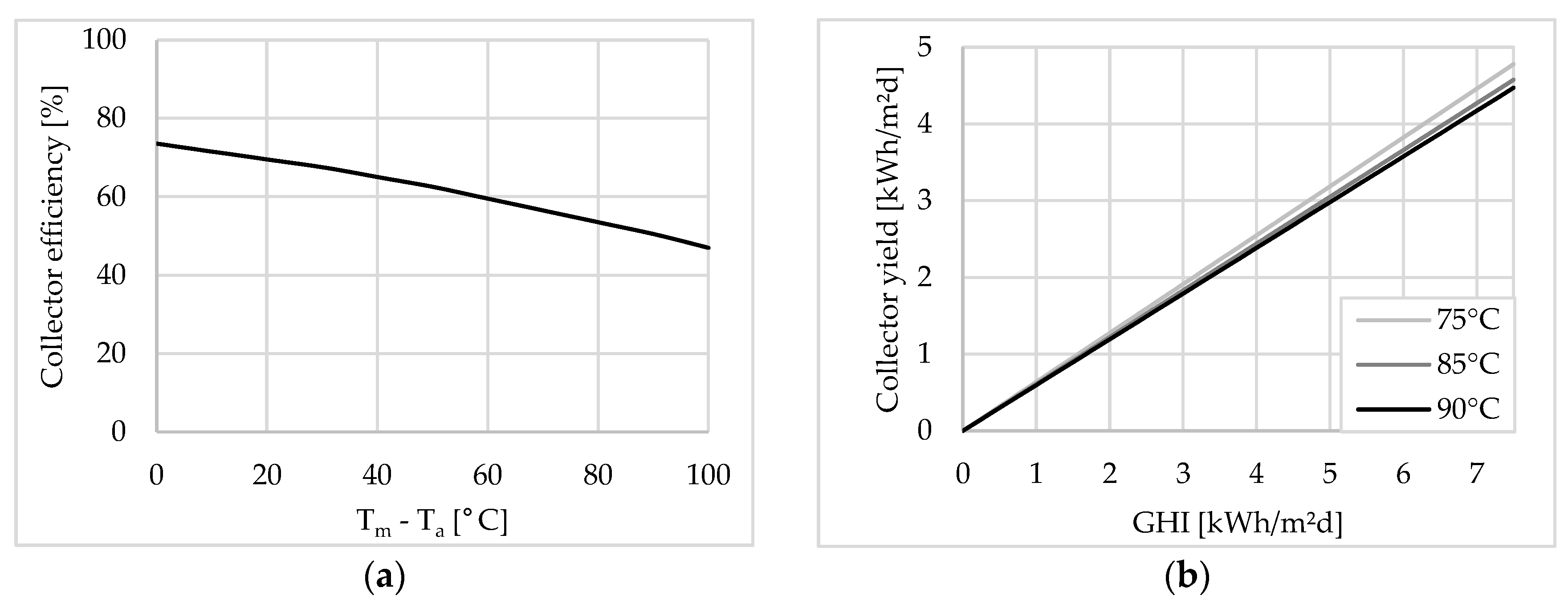
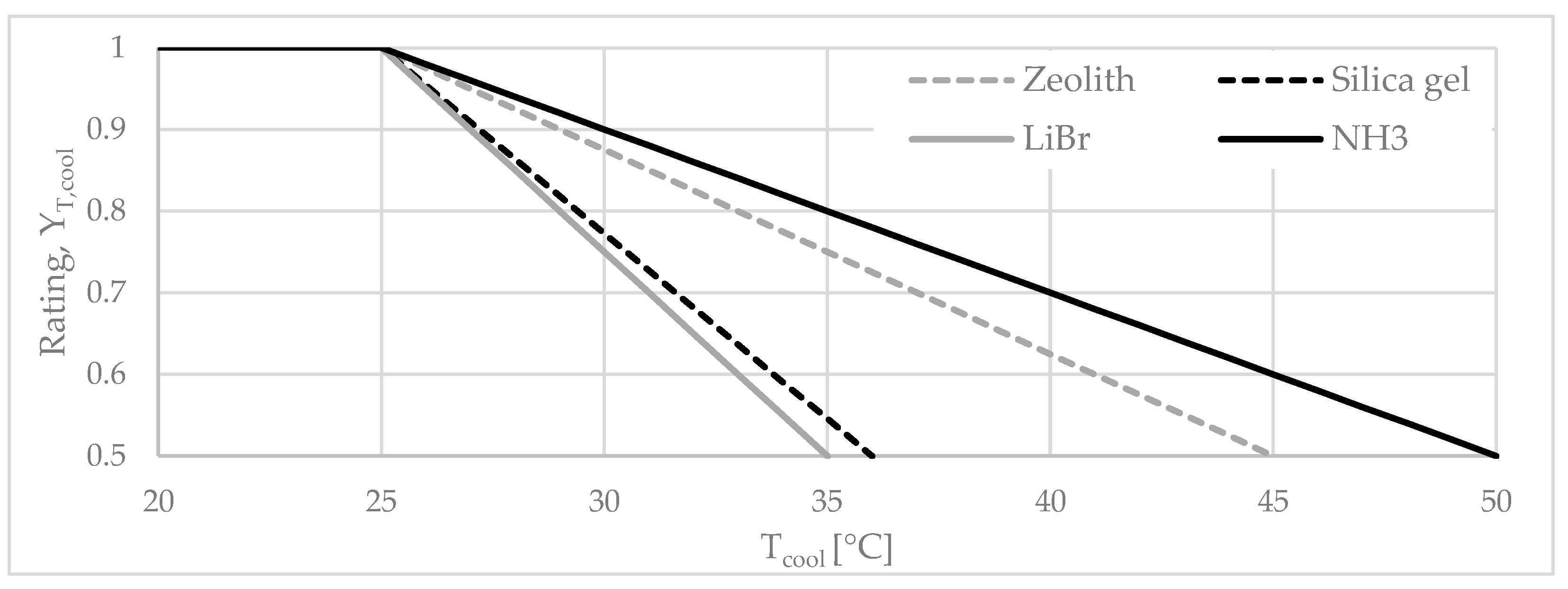
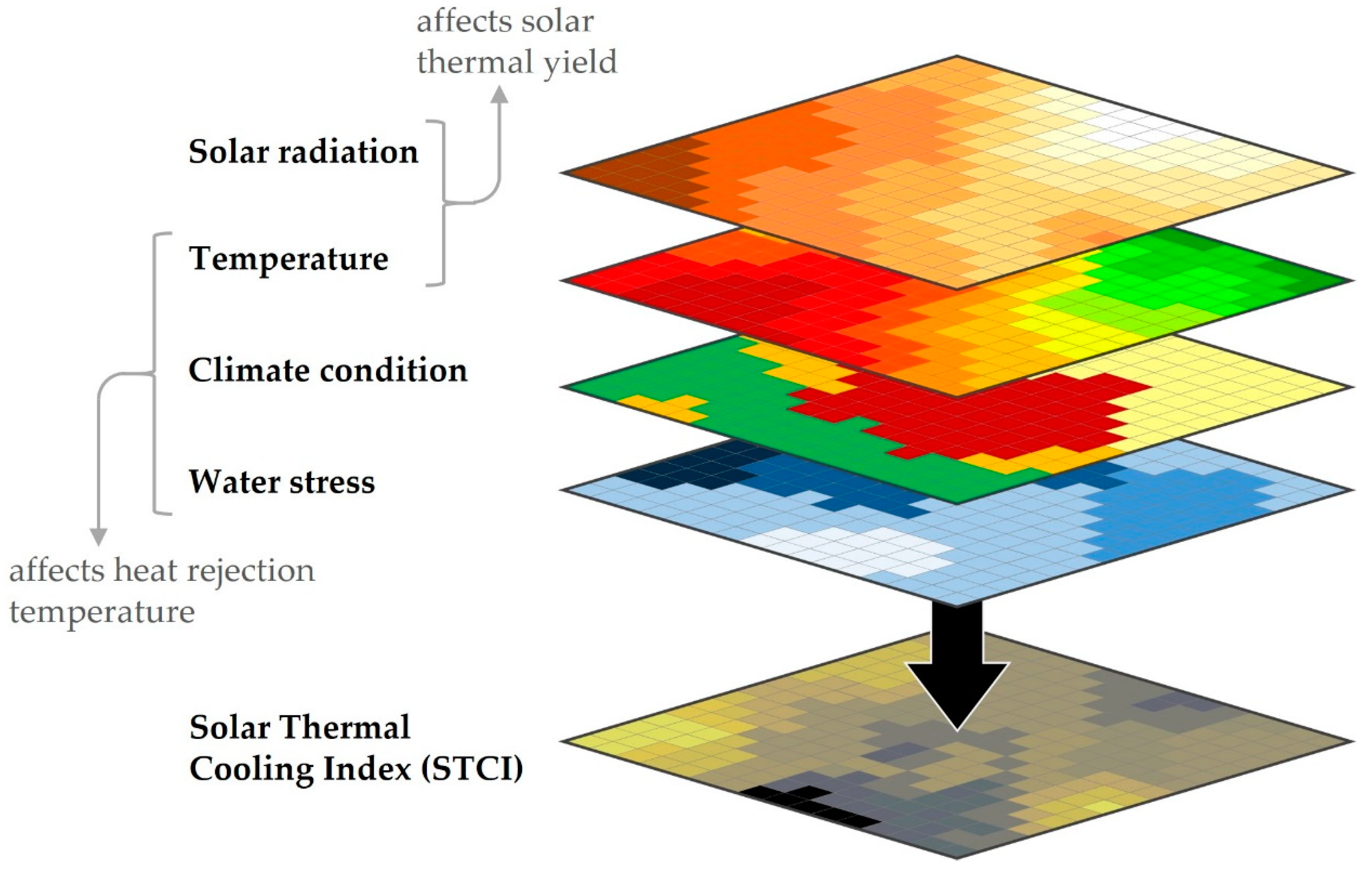
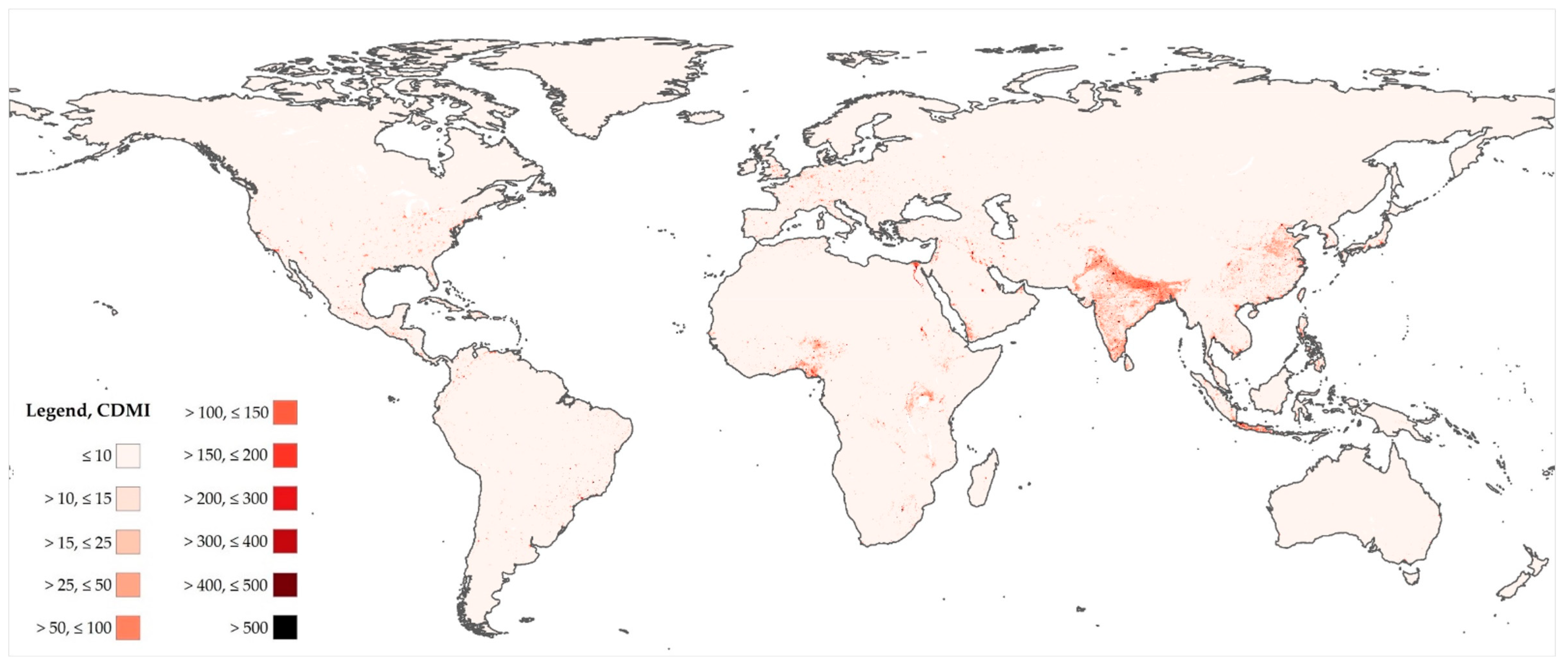


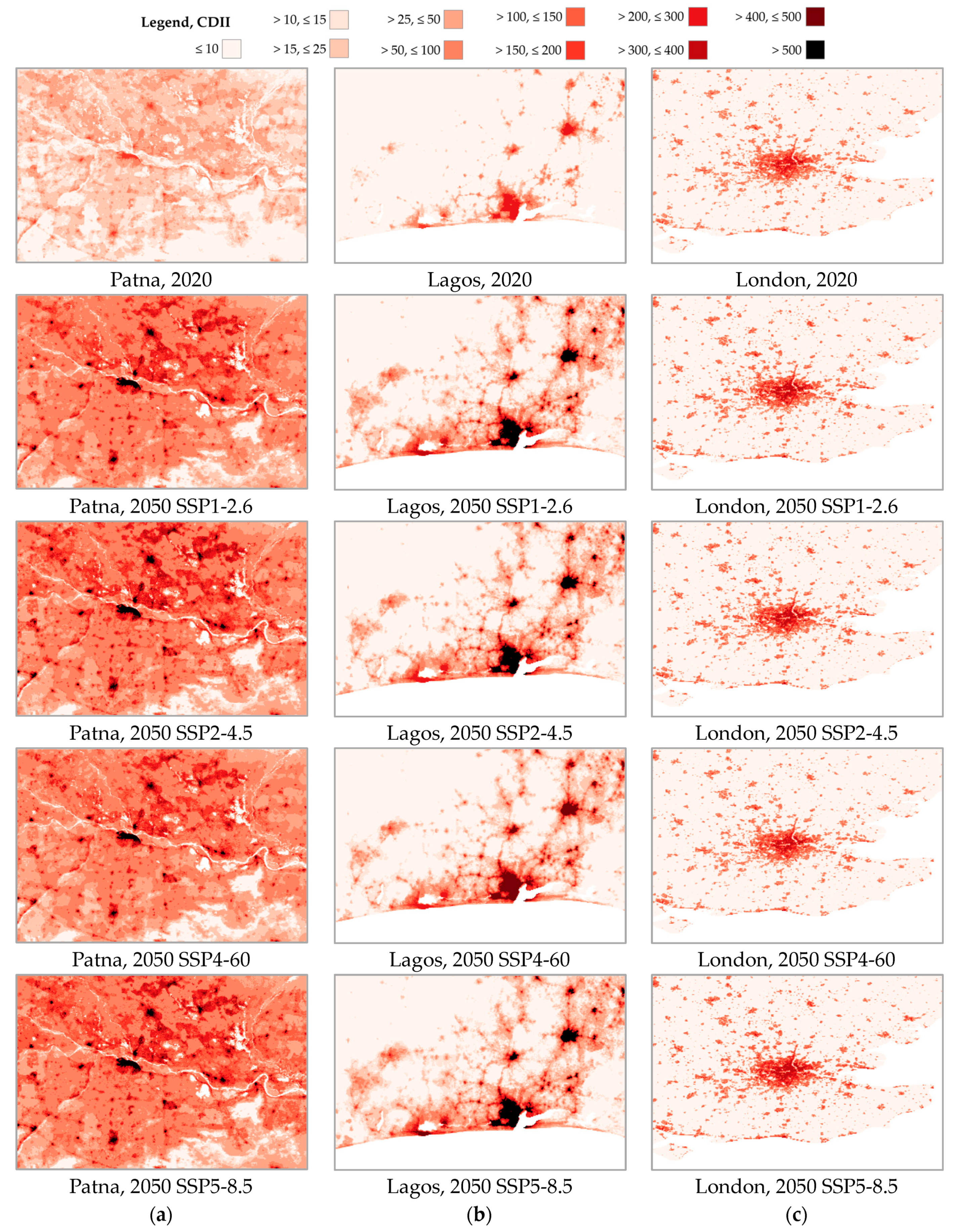

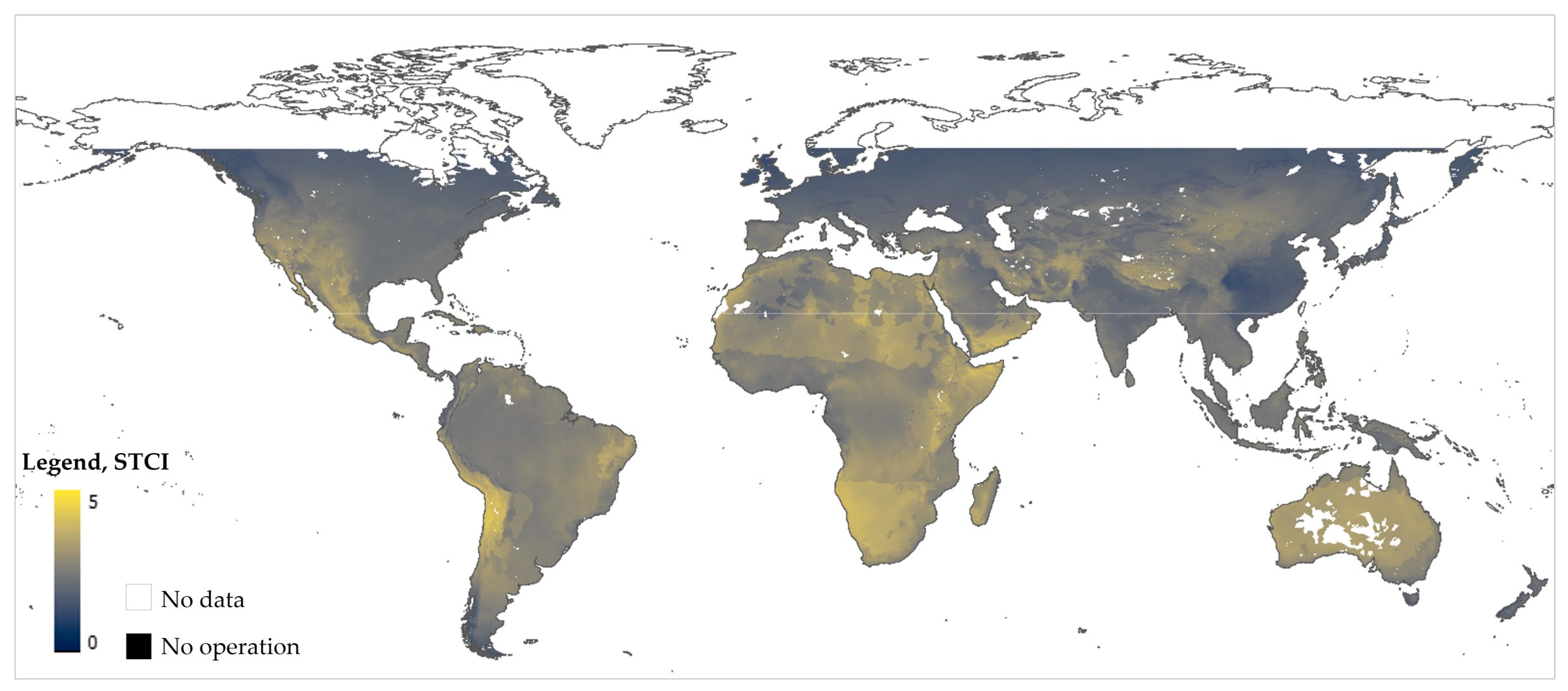
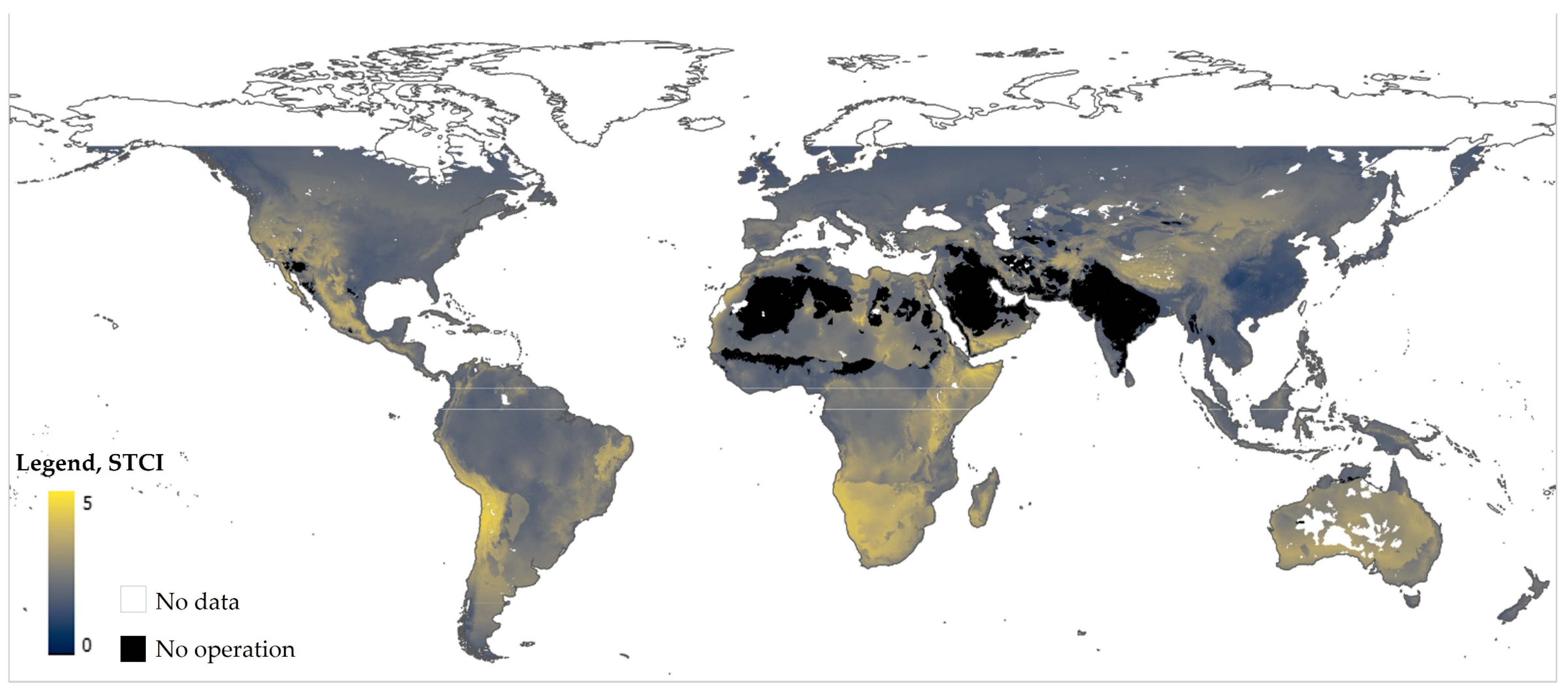
| Climate Zone | CDD Base Temperature | 18 °C | 22 °C | 23 °C | 24 °C | 25 °C | Sum of Weighted Mean CDD | XClimate |
|---|---|---|---|---|---|---|---|---|
| Weighting | 30% | 30% | 20% | 15% | 5% | |||
| BWh | Mean CDD | 5152 | 3691 | 3326 | 2960 | 2596 | 10 | |
| Weighted mean CDD | 1546 | 1107 | 665 | 444 | 130 | 3892 | ||
| Csa | Mean CDD | 2313 | 1516 | 1340 | 1174 | 1018 | 4.2 | |
| Weighted mean CDD | 694 | 455 | 268 | 176 | 51 | 1644 |
| Type of Data | Derived from/ Based on | Data Reference |
|---|---|---|
| CDD | [110] | 1970–2018 |
| Climate zone distribution | [111] | 1980–2016 |
| Population density | [91] | 2020 (SSP) |
| GDP per capita | [23,117] | 2020 |
| Climate zone distribution | [19] | 2050 (RCP) |
| Population density | [91] | 2050 (SSP) |
| GDP per capita | [23,115] | 2050 (SSP) |
| Energy Source | Physical Base | Sorption and Refrigerant Material | Thot [°C] | Tchill [°C] | Tcool, in [°C] | COPth (Nominal) |
|---|---|---|---|---|---|---|
| Thermal (single effect only) | Liquid (Absorption) | water/NH3 | 90 | 6 | 20–50 | 0.5–0.75 [118] |
| LiBr/water | 85 | 10 | 25–35 | 0.65–0.8 [118] | ||
| Sold (Adsorption) | Zeolite/water | 85 | 15 | 25–45 | 0.5–0.75 [118] | |
| Silica gel/water | 75 | 10 | 25–36 | 0.5–0.75 [118] |
| Type of Data | Derived from/Based on | Data Reference |
|---|---|---|
| GHI | [120] | 1994/1999/2007–2021 |
| Air Temperature | [19] | 2050 (RCP) |
| Climate Zone | [19] | 2050 (RCP) |
| Water Stress | [119] | 2050 (SSP & RCP) |
| Scenario 2050 | Type of Data | Absorption Chiller | Adsorption Chiller | ||
|---|---|---|---|---|---|
| LiBr | NH3 | Silica Gel | Zeolite | ||
| SSP2-4.5 | Coverage of world CDMI | 74% | 99% | 78% | 99% |
| Coverage of world area in STCI (in CDMI) | 94% (83%) | 100% (89%) | 95% (84%) | 100% (89%) | |
| SSP5-8.5 | Coverage of world CDMI | 72% | 99% | 76% | 99% |
| Coverage of world area in STCI (in CDMI) | 92% (80%) | 100% (87%) | 94% (82%) | 100% (87%) | |
Disclaimer/Publisher’s Note: The statements, opinions and data contained in all publications are solely those of the individual author(s) and contributor(s) and not of MDPI and/or the editor(s). MDPI and/or the editor(s) disclaim responsibility for any injury to people or property resulting from any ideas, methods, instructions or products referred to in the content. |
© 2023 by the authors. Licensee MDPI, Basel, Switzerland. This article is an open access article distributed under the terms and conditions of the Creative Commons Attribution (CC BY) license (https://creativecommons.org/licenses/by/4.0/).
Share and Cite
Strobel, M.; Jakob, U.; Streicher, W.; Neyer, D. Spatial Distribution of Future Demand for Space Cooling Applications and Potential of Solar Thermal Cooling Systems. Sustainability 2023, 15, 9486. https://doi.org/10.3390/su15129486
Strobel M, Jakob U, Streicher W, Neyer D. Spatial Distribution of Future Demand for Space Cooling Applications and Potential of Solar Thermal Cooling Systems. Sustainability. 2023; 15(12):9486. https://doi.org/10.3390/su15129486
Chicago/Turabian StyleStrobel, Michael, Uli Jakob, Wolfgang Streicher, and Daniel Neyer. 2023. "Spatial Distribution of Future Demand for Space Cooling Applications and Potential of Solar Thermal Cooling Systems" Sustainability 15, no. 12: 9486. https://doi.org/10.3390/su15129486





